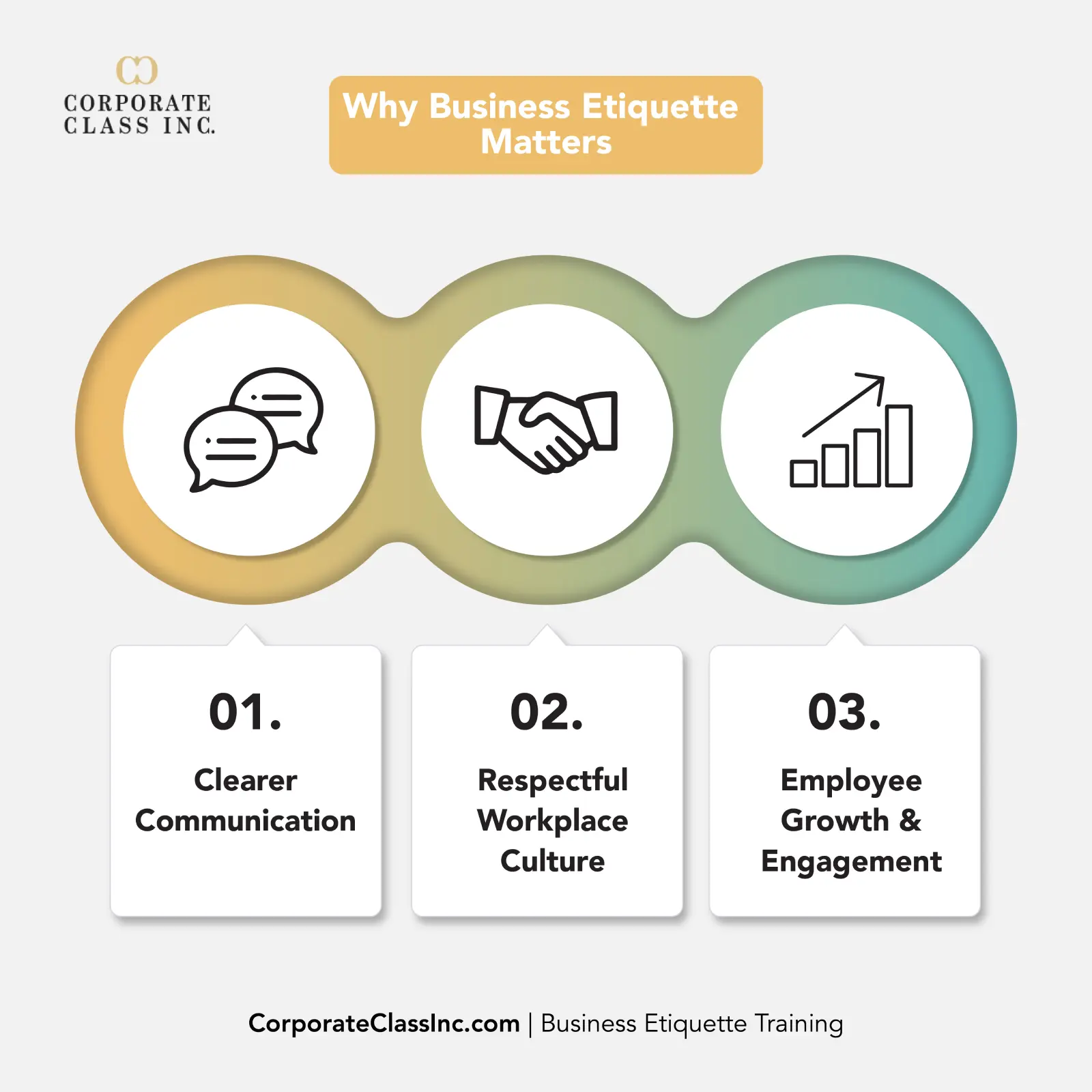Workplace culture can make or break a company’s success. Recently, The Globe and Mail released a report on the 50 most engaged workplaces in Canada, defining engagement as “employees’ passion for their work and commitment to the company’s vision.” Engagement directly influences employee retention, customer loyalty, and a company’s ability to meet objectives. One often overlooked but powerful factor in engagement is business etiquette.
From communication practices to leadership interactions, etiquette shapes daily experiences at work. When employees respect one another and understand the professional standards expected in business interactions, organizations thrive. In fact, the judging panel for the award assessed companies based on eight factors: communication, leadership, culture, rewards and recognition, professional and personal growth, accountability and performance, vision and values, and corporate social responsibility. Business etiquette plays a key role in several of these elements.
Key Takeaways:
- Business etiquette strengthens workplace culture by guiding respectful communication, professional growth, and positive leadership behaviours.
- Engaged workplaces in Canada often succeed because they integrate etiquette into communication, training, and daily interactions.
- Investing in etiquette resources and training improves employee confidence, collaboration, and long-term organizational performance.
The Role of Business Etiquette in Communication
Communication is the foundation of every workplace. It spans daily conversations with colleagues, formal presentations, and how professionals conduct themselves in writing or online. Business etiquette in business communication ensures that exchanges remain respectful, effective, and aligned with organizational values.
Technological communication, such as email, texting, phone calls, and video meetings, is unavoidable in modern business. Clear introductions on a conference call or respectful phrasing in a sensitive email are examples of how etiquette helps prevent misunderstandings. Learning structured communication skills can enhance productivity across all levels of an organization.
Face-to-face communication matters just as much. Whether in a casual hallway chat, a client dinner, or a networking event, the way employees present themselves influences both relationships and reputations. Business etiquette means maintaining awareness of tone, timing, and respect in every interaction.
Business Etiquette and Professional Growth
Organizations that invest in training and development reap long-term benefits. Workshops, seminars, and mentorship opportunities not only build skills but also increase confidence and collaboration. When business etiquette in Canada is included in these sessions, employees become more polished and self-assured.
Corporate Class Inc. offers an Executive Presence System covering interpersonal communication, workplace etiquette, techno-communication, presentation skills, business dress, and dining etiquette. Programs like these demonstrate that professional growth is more than technical knowledge, it also involves building awareness of how one’s actions affect team dynamics.
By sharpening etiquette skills, individuals strengthen their professional image and contribute positively to the entire workplace. Growth, in this sense, benefits both the employee and the organization.
Culture and Respect in the Workplace
Workplace culture reflects shared values and the environment employees create together. Respect is central to this culture, and etiquette provides the framework for showing that respect consistently. Business etiquette means treating colleagues, clients, and leadership with consideration, regardless of the setting.
When respect becomes routine, workplaces run more smoothly. Meetings stay productive, emails remain professional, and conflicts are managed constructively. Companies that prioritize etiquette often find themselves building cultures where employees feel valued and are motivated to contribute their best.
For companies operating across borders, understanding business etiquette in Canada ensures consistency while reflecting local professional standards. This reduces friction and builds trust within multicultural teams.

Business Etiquette in Leadership and Accountability
Leaders set the tone for professional behaviour. When managers demonstrate etiquette in how they give feedback, run meetings, and handle accountability, employees take notice. Etiquette in leadership signals fairness and encourages open dialogue without fear of embarrassment or dismissal.
By modeling respect, leaders establish a standard employees naturally adopt. This contributes to performance-driven workplaces where people feel both valued and accountable. Pairing leadership with etiquette ensures policies are not just enforced but also embraced with mutual respect.
Learning From Books on Business Etiquette
Practical resources extend beyond workshops. Many professionals turn to books on business etiquette to refine their skills independently. These resources often cover communication styles, cultural etiquette differences, and strategies for handling sensitive workplace situations.
When companies encourage employees to study these resources, they promote continuous learning. Pairing internal training with personal reading strengthens etiquette knowledge, creating well-rounded professionals ready to navigate diverse workplace challenges. For organizations, recommending a reading list of trusted books on business etiquette can be a simple, low-cost way to support growth.
Why Business Etiquette Matters for Engagement
Looking back at the Globe and Mail’s recognition of Canada’s top workplaces, the connection is clear. Companies that prioritize etiquette also see stronger engagement, higher retention, and improved customer relationships. Business etiquette touches multiple areas, including communication, culture, leadership, and growth, that directly influence engagement.
When organizations embed etiquette into their operations, they are not simply polishing appearances. They are building environments where people feel respected and empowered. For companies striving to stay competitive, understanding what business etiquette means is not optional; it is a strategic advantage.
FAQ
What does business etiquette mean in a modern workplace?
Business etiquette means a set of professional behaviours and standards that guide how employees communicate, collaborate, and present themselves. It covers everything from email tone to meeting etiquette and workplace attire. When practiced consistently, it strengthens trust and respect across an organization.
Why is business etiquette in Canada significant for companies with diverse teams?
Canada’s workplaces are multicultural, and employees often come from different cultural and professional backgrounds. Business etiquette in Canada provides a common framework for professional conduct, ensuring that interactions remain respectful and aligned with local expectations. This reduces misunderstandings and helps build cohesive, engaged teams.
What are some of the best resources or books on business etiquette for employees?
Companies often recommend books on business etiquette that cover communication, leadership, and cultural sensitivity. These resources provide practical advice employees can apply immediately. Pairing reading materials with workshops or executive coaching ensures both knowledge and practice are reinforced in daily workplace interactions.
Building Stronger Workplaces Through Business Etiquette
Business etiquette in business communication and everyday interactions directly shapes workplace culture. Companies that embrace etiquette see stronger engagement, smoother collaboration, and greater accountability. Understanding what business etiquette means, and applying it consistently, creates an environment where respect drives both performance and growth.






